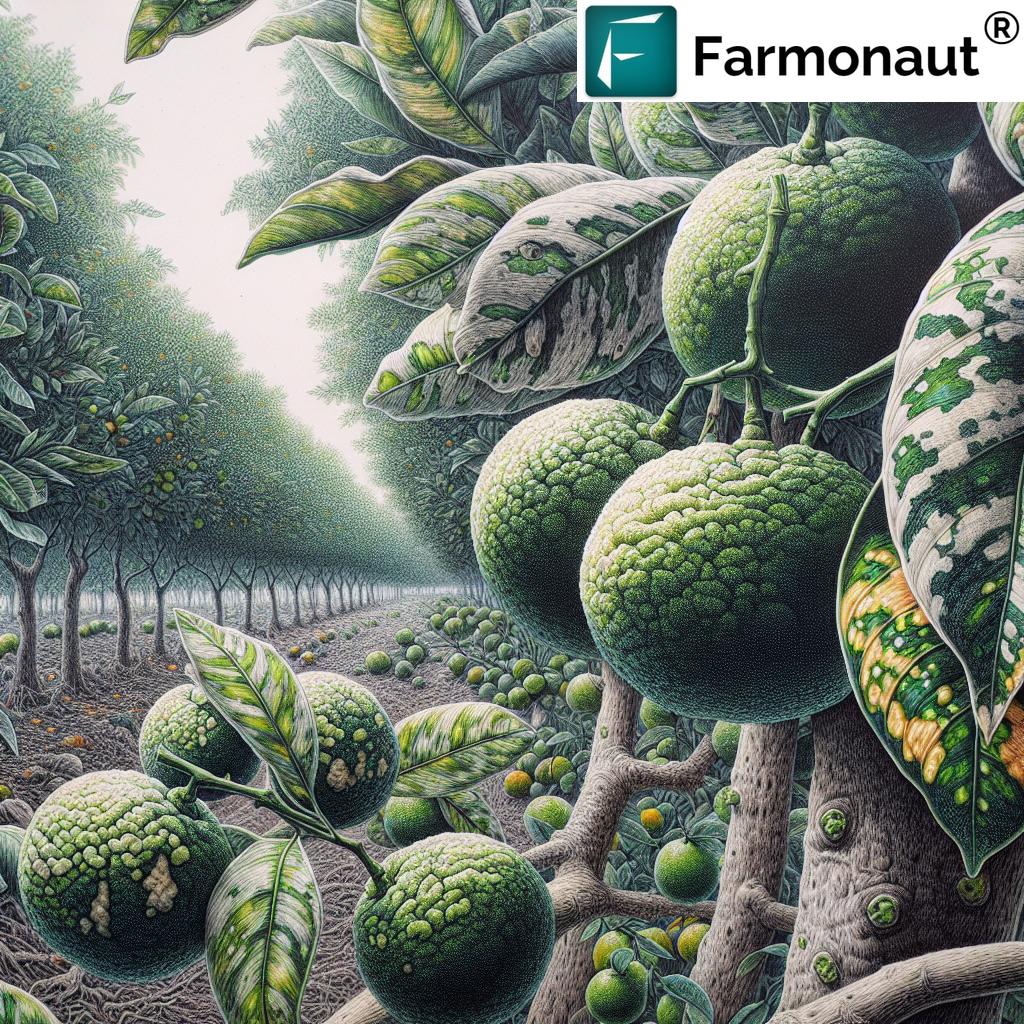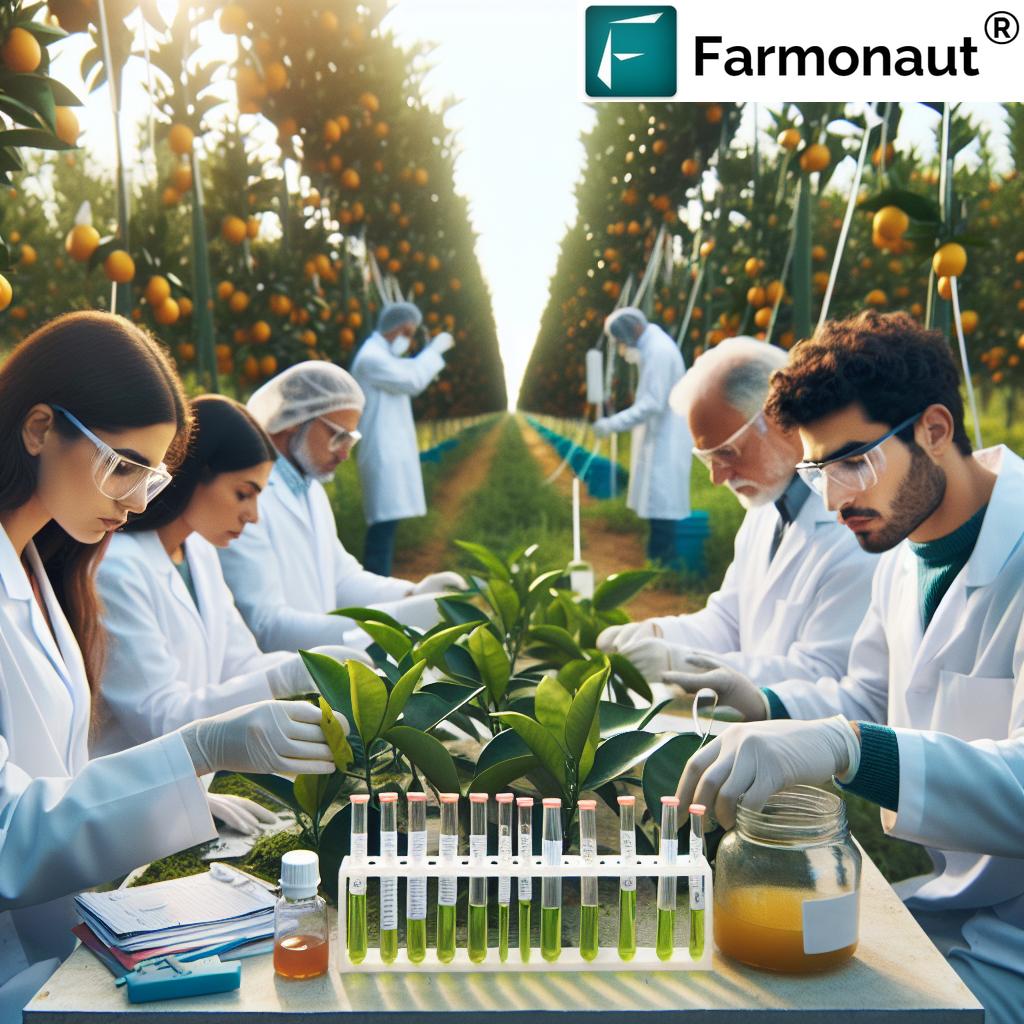Table of Contents
- Introduction: Citrus Greening Disease
- Global Impact & Economic Ramifications
- Huanglongbing Symptoms & Infected Citrus Tree Signs
- Understanding HLB: Etiology & Disease Transmission
- Solution Comparison Table for Citrus Greening Management
- 7 Innovative Solutions for Citrus Greening Disease in Florida
- Precision Technologies & Farmonaut’s Role
- Supporting the Global Citrus Industry
- FAQ: Citrus Greening Disease Solutions
- Conclusion: The Road to Recovery
- Farmonaut Subscriptions & Resources
Citrus Greening Disease: 7 Solutions for Florida
Citrus greening disease, also known globally as huanglongbing (HLB), is an insidious, bacterial citrus affliction spreading devastation through Florida’s groves and the wider global citrus industry. Since its identification in Florida in 2005, HLB—primarily caused by Candidatus Liberibacter species—has threatened both citrus production and the livelihoods of growers, demanding urgent, multifaceted intervention.
We aim to provide an informative, technology-focused overview of this critical agricultural challenge. In this blog post, we’ll clarify the symptoms of huanglongbing, examine the disease transmission and etiology, explore the economic impact on Florida and the global market, and critically compare the 7 most promising management solutions—from advanced biotechnology to real-time precision agriculture.
Citrus Greening Disease: Global Impact & Economic Ramifications
Citrus greening disease is not merely a Florida problem—its impact resonates globally, with consequences reaching Brazil, Asia, Africa, and the Americas. The decline in citrus production is particularly profound in major citrus-producing states like Florida, Texas, and California, as well as Brazil, the world’s primary orange juice exporter.
- Since HLB’s detection, Florida’s citrus production has plummeted by over 70%, devastating local economies and affecting thousands of jobs.
- Production costs in Florida have more than doubled, squeezing grower margins and pushing many out of the industry.
- Brazil forecasts its lowest orange harvest in three decades due to HLB and adverse weather (source).
- Infected groves yield lower-value, misshapen fruits and declining fruit quality, threatening international citrus markets and consumer prices.
As agricultural research organizations, growers, and innovators, we face a formidable fight to reduce the spread and economic consequences of this disease, which remains one of the most significant bacterial threats to global food security.
Huanglongbing Symptoms & Infected Citrus Tree Signs
Timely identification of huanglongbing symptoms is critical for effective disease management and containment. We encourage all involved in citrus agriculture—from growers to agritech professionals—to familiarize themselves with the unique markers of infected citrus trees:
Leaf Symptoms
- Yellowing of leaf veins is one of the earliest huanglongbing symptoms, followed by mottling—blotchy, asymmetrical yellow patterns on the foliage.
- Premature leaf drop and poor canopy development signal decline in tree vigor.
Fruit Symptoms
- Citrus fruits become small, misshapen, and develop thick, pale peels.
- The bottom of the fruit stays green (even when ripe, causing the “greening” name), and the taste may be distinctly bitter and sour—distinct markers of disease-infected fruit.
Tree Decline
- Emerging symptoms include stunted growth, twig dieback, and loss of overall vigor, leading eventually to tree death if unmanaged.
- Yield and fruit quality drop significantly, compounding the economic impact of citrus greening disease.
Growers should immediately investigate Disease Transmission Vectors if these signs are observed to reduce further spread in Florida groves and beyond.
Understanding HLB: Etiology and Citrus Disease Transmission
The etiology of citrus greening disease is rooted in bacterial pathogens of the genus Candidatus Liberibacter, primarily L. asiaticus, L. africanus, and L. americanus. The disease transmission hinges on sap-sucking insects—the psyllids—that act as major disease vectors:
- Asian citrus psyllid (Diaphorina citri) is the primary vector in Florida, Texas, California, and much of Asia/Americas.
- African citrus psyllid (Trioza erytreae) prevails in parts of Africa and parts of the Middle East.
Once psyllids feed on infected trees, they acquire the bacterial pathogen and transmit it through their feeding to healthy trees—compounding the spread and establishing secondary disease hotspots. Effective psyllid control strategies are the cornerstone of current citrus greening management plans worldwide.
- Citrus disease transmission is typically unidirectional—the psyllid receives the bacterium from an infected tree and introduces it to uninfected groves, resulting in secondary spread.
- The entrenched nature of vector populations and the lack of an effective cure mean that most management strategies focus on slowing transmission, removing infected trees, and exploring technological and biotechnological remedies.
Solution Comparison Table for Citrus Greening Management
Before we dive into Florida’s 7 innovative solutions for citrus greening prevention and control, let’s compare the core approaches using evidence-based estimates for citrus disease management:
| Solution | Description | Estimated Effectiveness (%) | Implementation Cost (USD/acre) | Technological Maturity |
|---|---|---|---|---|
| Heat Treatment | Applying controlled heat to infected trees to kill Candidatus Liberibacter bacteria within the trunk and foliage. | 55-65% | $250 – $350 | Emerging |
| Insecticide Application | Targeted use of approved insecticides to reduce psyllid populations and thus minimize disease spread. | 60-75% | $180 – $260 | Established |
| CRISPR Biotechnology | Gene editing of citrus plants to disrupt susceptibility genes or enhance resistance to HLB. | Potentially >85% | $350+ (R&D stage) | Experimental |
| Resistant Varieties | Breeding and planting of genetically modified or naturally resistant citrus tree cultivars. | 75-85% | $220 – $370 | Emerging |
| Biological Control Agents | Deployment of natural predators or parasitoids to manage psyllid vectors. | 50-70% | $130 – $210 | Emerging |
| Nutritional Supplements | Application of micronutrients and foliar sprays to strengthen tree vigor and delay decline. | 30-45% | $120 – $185 | Established |
| Early Detection Tech | Use of satellite and sensor-based tools for early identification of symptomatic trees, enabling swift response. | 70-85% | $60 – $130 | Emerging/Established |
This table underlines the variety and innovative scope of effective citrus greening management strategies. As we’ll discuss, a blended approach, tailored for Florida’s unique agroecological context and leveraging precision technology solutions—such as those offered by Farmonaut—is essential for real, long-term success.
7 Innovative Solutions for Citrus Greening Disease in Florida
Let us take a closer look at these seven principal solutions, each reflecting the current state of global research, local practicalities, and technological innovation in citrus greening prevention and control:
-
1. Heat Treatment of Citrus Trees
Controlled heat therapy is being studied as one method to kill or reduce bacterial loads of Candidatus Liberibacter asiaticus within infected trees. While not a cure, it may delay decline if implemented early, especially in young groves. Operational complexity and cost, however, limit broadscale adoption.
-
2. Strategic Insecticide Application
Integration of targeted insecticides, used according to resistance-management protocols, remains a key direct method for psyllid control strategies. While this offers quick knockdown of psyllid populations to reduce immediate disease transmission, concerns remain about beneficial insects and chemical residues.
- Best implemented in conjunction with biological controls and precise timing based on real-time pest monitoring data—a service conveniently provided through Farmonaut’s large-scale farm management platform.
-
3. CRISPR/Cas9 and Genetic Engineering
One of the most promising areas in contemporary citrus greening management involves the use of CRISPR gene editing and genetic modification. Scientists are using CRISPR/Cas9 to:
- Insert or modify genes that enhance disease resistance within citrus trees.
- Disrupt genes that enable effective bacterial colonization by Candidatus Liberibacter.
- Explore expression of compounds toxic to psyllid vectors while being safe to non-target organisms (further reading).
This approach holds transformative potential, but genetically modified citrus trees may take years to reach commercial scale in Florida due to regulatory and acceptance hurdles.
-
4. Planting of Resistant Varieties
Breeding and planting naturally resistant or genetically engineered citrus cultivars are vital citrus greening prevention methods. Researchers are identifying rootstocks and scions with either natural resistance to HLB or those bred for improved disease tolerance and overall tree vigor.
- While not immune, these varieties can maintain fruit production in the presence of HLB, reducing economic losses for Florida growers.
-
5. Biological Control Agents
Augmenting the ecosystem’s natural defenses by deploying biological control agents—such as parasitic wasps that prey on psyllid nymphs—offers an environmentally friendly counterpoint to chemical control. Research is ongoing to optimize release rates and establish sustainable populations in commercial groves. These agents can be strategically integrated into highly monitored citrus production systems.
-
6. Nutritional Supplementation Programs
Bolstering tree health with enhanced micronutrient foliar sprays (zinc, manganese, magnesium) or soil amendments can delay the decline of infected trees, helping to sustain yields while more permanent solutions are developed. Though not a cure, this approach buys time and helps growers maintain income stability.
- Combining satellite-guided irrigation and nutrient management (as offered in Farmonaut’s web app) can further optimize supplement efficacy.
-
7. Early Detection & Precision Monitoring Technologies
Early detection is paramount for effective citrus greening management. Precision agriculture platforms, such as those provided by Farmonaut, use AI-driven analysis of satellite and drone imagery to:
- Identify subtle shifts in NDVI (Normalized Difference Vegetation Index)—a marker of plant health—before visible symptoms occur.
- Enable early intervention, accurate mapping of affected zones, and resource optimization, thus containing outbreaks and minimizing losses.
Discover more about early detection and remote crop health analytics in Farmonaut’s large scale farm management offering.
Precision Technologies & Farmonaut’s Role in Citrus Greening Management
The complexity of citrus greening management in Florida underscores the urgent need for affordable, scalable, and advanced farm technology. At Farmonaut, we harness the synergy of satellite data, artificial intelligence, and real-time crop health monitoring to support every level of Florida’s citrus industry. Here’s how our platform empowers decision making throughout the disease lifecycle:
-
Real-Time Crop Health Monitoring:
Leverage multispectral satellite imagery and NDVI indices for early detection of tree decline, stress, and subtle huanglongbing symptoms at the block or tree level. -
AI-Based Advisory (Jeevn AI):
Personalized AI agronomic recommendations (pertaining to spray schedules, irrigation timing, and nutrition) can help mitigate secondary impacts of HLB on fruit quality and production. -
Blockchain-Based Product Traceability:
Protect the integrity of Florida’s citrus market by enabling farm-to-market traceability, securing every stage of the supply chain—from grove to global consumer. This helps in tracking origin and quality, vital for disease-impacted markets. -
Fleet and Resource Management:
Optimize spray, harvest, and transport logistics within and between groves via Farmonaut’s fleet management tools, reducing costs while prioritizing healthy orchard blocks. -
Carbon Footprint Monitoring:
For those seeking to combine sustainability with profitability amid rising consumer and regulatory expectations, Farmonaut’s carbon footprint tracking aligns citrus farms with green practices, even in the face of crisis. -
Verified Crop Loan & Insurance Access:
Satellite-based monitoring supports faster and fraud-resistant crop loans and insurance claims—mitigating economic shocks caused by sudden tree decline in infected groves.
Our API is available for research institutions, tech developers, government agencies, and cooperatives for direct satellite data and weather integration (API portal, developer docs).
Whether you manage a small family orchard or Florida’s largest groves, Farmonaut’s scalable solutions bridge the gap between traditional expertise and next-generation disease management. Growers, agribusinesses, governments, and financial institutions alike leverage our tools for precision agriculture, transparency, and sustainable production.
Learn more about comprehensive, affordable digital agronomy for crop, plantation, and forest advisory through Farmonaut’s unified platform.
Supporting the Global Citrus Industry: The Broader Impact of HLB
The spread of citrus greening disease in Florida, Texas, California, and globally requires that we advocate for policy-driven, research-based approaches while empowering local innovation. The loss of citrus groves risks:
- Reduced fruit quality and quantity available to global consumers, raising prices for juices and fresh fruit.
- Increased industry consolidation, with many small and mid-sized growers unable to cover rising mitigation costs.
- Job losses across agricultural sectors, from field workers to processing plants and global supply chains.
- Strain on food security, nutritional health, and trade balance—especially in regions like Florida, Brazil, and the Mediterranean basin.
Only by coupling traditional agricultural wisdom with innovative technologies, data-driven insights, and collaborative action can we create a resilient, adaptive citrus industry in the face of bacterial citrus diseases.
FAQ: Citrus Greening Disease Solutions
What causes citrus greening disease?
Citrus greening (HLB, or huanglongbing) is primarily caused by the bacterium Candidatus Liberibacter asiaticus, transmitted via insect vectors known as psyllids—especially the Asian citrus psyllid in the United States.
What are the main symptoms of infected citrus trees?
The most common huanglongbing symptoms include yellowing and mottling of leaves, premature leaf drop, stunted tree growth, twig dieback, and fruit that remains green at the bottom, is misshapen, and tastes bitter.
Can citrus greening disease be cured?
There is currently no absolute cure for HLB. Management focuses on early detection, removal of infected trees, vector control, and integrating emerging solutions such as resistant varieties and biotechnological treatments.
Is there a way to prevent the spread of HLB in my grove?
We recommend frequent scouting, rapid removal of symptomatic trees, strict psyllid control strategies (via insecticides and biological agents), and regular use of real-time crop health monitoring technologies like Farmonaut to facilitate early detection and response.
How can precision agriculture and data-driven platforms help?
Satellite and AI-driven platforms like Farmonaut offer timely, cost-effective management of large citrus holdings by providing early detection of yield-limiting stress, suggesting optimal management zones, and integrating weather, pest, and operational data for risk mitigation.
Is it possible to get satellite-based insights for small family groves?
Absolutely! Farmonaut’s platform is designed to serve both smallholder and large-scale growers. The intuitive web and mobile apps allow growers of any size to access NDVI maps, weather advisories, and detailed crop health analytics at a fraction of traditional precision farming costs.
Conclusion: The Road to Recovery in the Citrus Industry
Citrus greening disease (HLB) stands as the greatest challenge to modern citrus production worldwide. The devastating impact of this bacterial affliction, driven by the transmission of Candidatus Liberibacter species through psyllid vectors, has transformed Florida’s rural economy and shifted the course of the global citrus industry.
A future-proof response demands integrated management strategies, continuous innovation, and a commitment to knowledge-driven action:
– Early detection and rapid response to infection.
– Use of AI, satellite, and sensor-based precision agriculture platforms to scale up best practices.
– Promotion of biological, genetic, and nutritional solutions tuned to local realities.
– Real-time supply chain traceability to maintain market trust amid uncertainties.
Only through collaboration, technological adoption, and broad dissemination of actionable knowledge can we sustain citrus cultivation for the future. The battle for Florida’s groves is the testing ground for a global strategy—where every new innovation, from biotechnology to AI-powered farm monitoring, brings us a step closer to resilience and recovery.
Farmonaut Subscriptions & Resources
Take the next step with Farmonaut to safeguard your citrus investments using the power of satellite-based crop health analytics, AI advisory, blockchain traceability, and much more.
- Web, iOS, and Android App Access
- API Services for Crop, Orchard, and Climate Data
- API Developer Docs
- Carbon Footprinting Tools
- Product Traceability Platform
- Fleet and Farm Resource Management
- Large Scale Farm Management
- Crop Loan and Insurance Support
For the best in value, scalability, and innovation in citrus farming, see the current Farmonaut subscription options below:
Let’s work together to detect, manage, and ultimately overcome citrus greening disease—helping Florida, and the world, build a sustainable, high-quality citrus future.


















